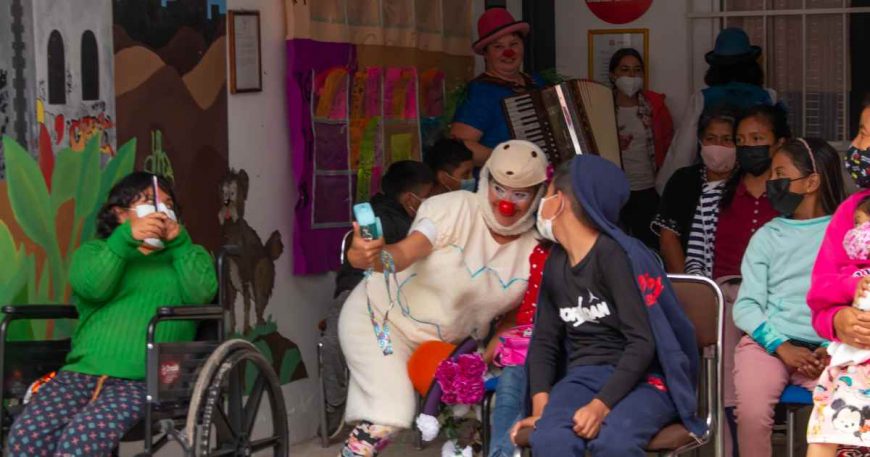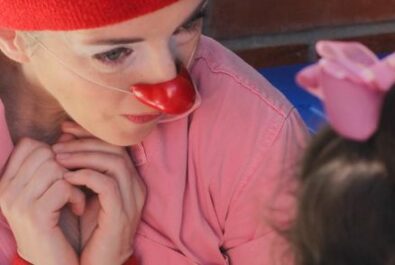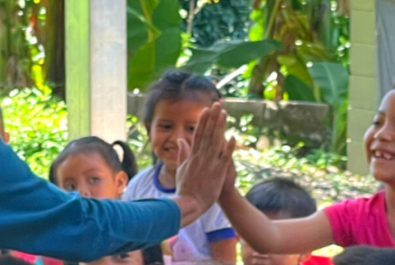Check out our April 20-28 tour in the Bay Area of the United States!

4 Ways Play Helps Connect: Examples from Human Trafficking Survivors in Mexico
When was the last time play helped connect you and a friend?
Maybe you were making music, getting your groove on, or playing pickleball.
At Clowns Without Borders, we rely on the power of play to help connect people to each other and to their hopes and dreams of a better world.
In this post, the four CWB artists who performed in Mexico this past August (Luz, Darina, Vanessa, and Molly) each share a story of how women and girls in Mexico use play to connect and dream of a bright future. The stories are especially inspiring because these girls and young women have survived human trafficking.
Please note: This post includes information about human trafficking and sexual exploitation. At CWB, we’re committed to sharing the context within which we work, including naming the human rights violations our audience members have experienced. We understand this content may be upsetting. If you prefer to skip the post and go straight to the photo montage video, click here.
1. Play creates emotional connection and leg appendages (Luz’s story)

I have an act with a fake fish that I am trying to catch to make a taco, and after a few minutes of me running around wildly onstage with the fish, I came to a moment of relative stillness.
With the fish still wiggling wildly in my hand, a tiny girl rushed onstage and hugged my leg. She kept coming back onstage during the show and, eventually, Vanessa just picked her up and continued with our schtick as planned, the tiny girl in her arms.
Luz Gaxiola
This little girl wanted nothing more than to play and connect with the clowns who were the source of that play. Wrapping herself around Luz’s leg was a visceral act that expressed the love, appreciation, and connection she felt for the clowns who were offering play.
When children play, they feel safe.
2. Like magic, play gives you new perspectives (Darina’s story)

Obviously, you don’t need to be a refugee to experience the feeling of friendlessness. Humans just feel that way sometimes. As a human who reads this blog, I believe you’ll be able to empathize with the range of emotions expressed by a woman from our Puebla audience.
In the show, my character is a lamb who has lost her home and her family. The clowns make a dream machine and we all put in our dreams for the world, and then invite the audience to join us. It starts out silly, “Cats! Horses! Dogs! Flowers!”
Then a woman stands up and says, “At the moment you told your story, I identified. I am a refugee. I don’t feel I have a home. And only now do I feel like I have friends.”
Darina Robles
Indeed, play helps connect when nothing else does.
The woman from Puebla felt safe being vulnerable with the clowns and the audience after engaging with the lost-lamb story and laughing together.
Human Trafficking in Mexico Linked to Migration
- 85% of human trafficking victims in Mexico are women and girls. Mexico’s National Human Rights Commission
- The actual number of victims is likely 100x higher than what’s reported.
- The people at highest risk of being trafficked in Mexico are unaccompanied children, Indigenous persons, asylum seekers and migrants, people who identify as LGBTQI+, and informal sector workers. US State Department
3. Play locks in positive memories of being together (Vanessa’s story)

We were performing at a cultural center, and the children of the neighborhood were very shy. At the end of the show, a group of kids got very close to me but didn’t say anything.
“Do you want a hug?” I asked.
Their eyes got wide, and first one, then the rest, nodded and responded, “Si!”
We all hugged, and then the kids giggled and ran off.
Two other kids, who had been on the side, walked over, carrying a notebook. They showed it to me, and it was a picture of us four clowns. They asked me to sign it, then they hugged it back to their chests.
Vanessa Nieto
When Vanessa took time to connect with the kids at their energy level through hugs and autographs, she did it out of love. What was also happening was that she was supporting the creation of peak moments. These peak moments would later allow the children to better evaluate and remember their experiences.
The peak-end rule is a psychological heuristic in which people judge an experience largely based on how they felt at its peak (i.e. its most intense point) and at its end, rather than based on the total sum or average of every moment of the experience.
Daniel Kahneman
Peak-End Theory creator and Nobel Prize-winning Israeli psychologist
4. Play supports personal transformation (Molly’s story)

We learned from a workshop with the director of a refuge for girl survivors of sex trafficking that most of the girls (aged 13 to 18 years) at the refuge were sex trafficked by their mothers or grandmothers, who themselves had been victims of human trafficking.
We also had a lecture and discussion on trauma and its effects with a psychologist who specializes in that work. She had told us she loves butterflies because they carry the possibility for transformation. She said that people in zones of trauma tend to draw butterflies.
Later that day, we built a butterfly skit into the show.
During the show, as Dari completed her transformation from a gusanito (caterpillar) into a butterfly, one girl pointed straight up into the air and shouted excitedly, “Mariposa!” We all looked up, and I could just see the silhouette of a butterfly as it exited from view.
In the butterfly transformation moment in the show, an actual mariposa had flitted over our heads.
Everyone, the girls and clowns alike, were buzzing and chattering with excitement at the perfection of the timing. The person who had spotted it was saying over and over, “I saw it, it was una mariposa, it flew right over us.” Girls kept repeating the word ‘mariposa’ with wonder in their voices as they looked up into the blue sky.
Molly Shannon

Because the audience had been engaged with play, they were in a state of reduced stress and increased creativity. This gave them a major advantage in learning and processing a concept they may not have considered before: Transformation is real and possible.
Conclusion
These inspiring stories from CWB artists demonstrate the power of play. Play can transform, create peak memories, offer new perspectives, and provide a sense of safety that leads to emotional connection.
We’d love to know: How will you play today?
Girls and women survivors of human trafficking in Mexico experienced 11 playful shows (reaching 2,355 people). All shows were produced and performed by CWB artists Darina Robles, Molly Shannon, Luz Gaxiola, and Vanessa Nieto.
Our partner was Llaven Nü. María José Díaz de Rivera managed logistics, and Arturo Reyes was our photographer and documentalist.
Check out the photo montage video from our August 2022 Mexico tour!




